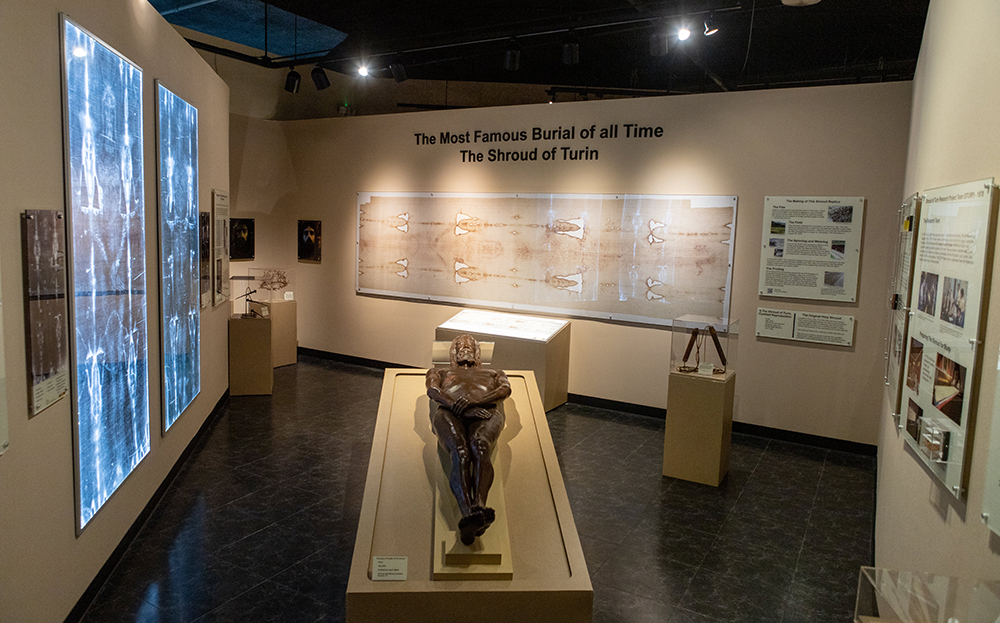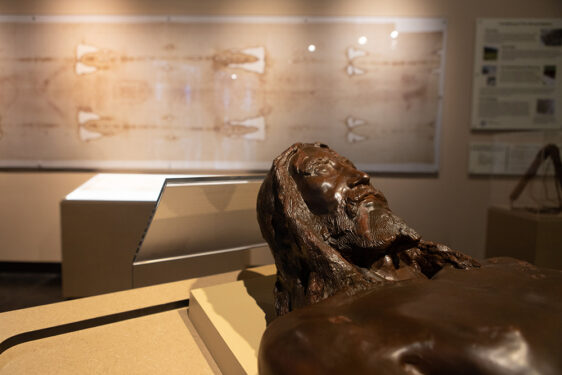
By Jo Ann Zuñiga, James Ramos
HOUSTON (OSV News) — Entering a cavelike entrance, visitors at the National Museum of Funeral History in Houston confront a life-size statue lying in the tomb, a replica of the man’s body image from the Shroud of Turin.
Sculpted by Italian artist Luigi Enzo Mattei, the body shows some of the suffering endured but in a subdued manner. The dark, bronze-colored resin statue highlights a gaping hole in his side, in each of his wrists, his feet and other wounds. Across on a wall of the compact space, a 14-foot replica of the well-known Shroud of Turin looms as the possible burial cloth of Jesus.
The new exhibit, the only permanent display of the shroud in the U.S., reveals a few surprises.
Rather than a “crown” of thorns, a replica of what Roman soldiers created is called a “helmet of thorns” displayed in a case. Based on the wounds indicated on the shroud, the thorns covered the head and extended into the neck.
Also, in a nearby case, the expected long wooden shaft of a Roman spear. But the large diamond-shaped spearhead is bigger than expected and was used to violently thrust upward into the sides of the crucified rather than a slash usually depicted.
The shroud exposition sits adjacent to the museum’s lengthy exhibit on the death of the popes and features two life-size, back-lit screen displays of the shroud’s photonegative scans from official studies. Visitors have room to view the shroud up close, a certified linen reproduction gifted to the Archdiocese of Galveston-Houston from the Archdiocese of Turin, Italy.
The shroud replica is just one of seven authentic reproductions recently made available by Turin officials for public display around the world. The linen, made from flax grown in Bergamo, Italy, was used by Lino Val Gandino to produce the shroud during the coronavirus pandemic in
November 2020.
Cardinal Daniel N. DiNardo of Galveston-Houston, who blessed the new exhibit with
holy water, said to a preview crowd of about 200: “The Shroud of Turin and devotion to it has had a varied history in the church, and in the world, but has led many to contemplate more deeply the central mysteries of the Christian faith, principally the historical reality of Jesus’ life, death, and resurrection.”
Recognizing that Orthodox Easter had just been celebrated by the Eastern Orthodox Church a week prior, Cardinal DiNardo said, “Holy Friday is a celebration of Christ’s burial,” which includes a tapestry of Christ in the tomb that’s carried into the middle of the church.
“People recognize that the shroud is a place to recognize what Christ did for us,” he said. “Honoring a symbolic shroud of the dead Christ is important to grow in our devotion. This exhibit is in keeping with the long history of honoring the Shroud of Christ as an important item of devotion among the Christian faithful.”
With the replica of the shroud now on display, Cardinal DiNardo blessed the image for its goal of public veneration and education. He said he hoped the exhibition would inspire visitors who come to learn more about the passion, death and burial of Jesus “might be moved to learn more about the ministry of Christ as it shines forth in the Gospels themselves.”

Cardinal DiNardo also applauded the exhibit as the result of a long collaboration between the Archdiocese of Turin and active Catholics of the local church in Galveston-Houston.
Another speaker, Nora Creech, served as the principal developer of the museum exhibit titled “The Most Famous Burial of All Time,” which opened April 26. Creech, who earned a master of arts in faith and culture from the University of St. Thomas in Houston, also completed the shroud studies course offered by the Pontifical Athenaeum Regina Apostolorum in Rome.
She collaborated with Father Jared Loehr, a member of the Legionaries of Christ, who, then a transitional deacon in ministry in Houston, had visited the museum. Father Loehr, now in Dallas, met Creech through the online course offered by his congregation’s pontifical university that also houses a permanent exhibit on the shroud in Rome.
Creech highlighted the detailed study by a team of researchers completed in 1978 by the Shroud of Turin Research Project, known as STURP. Based on the findings of their scientific investigations, they concluded that “the shroud image is that of a real human form of a scourged, crucified man. It is not the product of an artist. The blood stains are composed of hemoglobin and give a positive test for serum albumin.”
In conjunction with a separate event in Houston, scientist Rudolph Dichtl and technical photographer Barrie Schwortz, who were part of that STURP, the first and only U.S. examination of the shroud, also came to speak on an expert panel.
Schwortz said, “At first, I said, ‘I’m Jewish and not interested in participating in the study.’ But then I changed my mind. I examined for paint or any pigment. I immediately realized this is not a painting, artwork or manufactured. I knew it was authentic.”
Electrical engineer and physicist Rudolph Dichtl said the team actually slept in the room with the shroud since they were granted only 125 hours to examine, which they did over five days.
Regarding the image of a person on the shroud, “the question of how the image was produced or what produced the image remains, now, as it has in the past, a mystery,” the STURP team concluded. Researchers said, “there are no chemical or physical methods known which can account for the totality of the image, nor can any combination of physical, chemical, biological or medical circumstances explain the image adequately.” Dichtl said, “As a scientist, there is no doubt to me that the cloth is authentic. As a Christian, I believe it could be the burial cloth of Jesus.”
In April 2020, amid the pandemic, the Archdiocese of Turin held a special livestream event, showing the original shroud to the world through the internet. In response to this event, Pope Francis wrote that he was joining the millions of viewers to also turn his gaze “to the Man of the Shroud, in whom we recognize the features of the servant of the Lord, that Jesus realized in his passion.”
